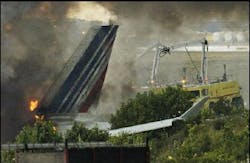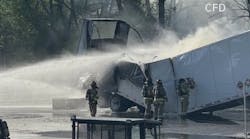TORONTO (AP) -- A jetliner carrying 309 people skidded off a runway while landing in a thunderstorm, sliding into a ravine and breaking into pieces, but remarkably everyone aboard survived by jumping to safety in the moments before the plane burst into flames.
Some 43 passengers suffered minor injuries in the 4:03 p.m. (2003 GMT) Tuesday crash landing of Air France Flight 358 from Paris _ the first time an Airbus A340 had crashed in its 13 years of commercial service.
The plane, carrying 297 passengers and 12 crew, overran the runway by 200 yards (meters) at Toronto's Pearson International Airport, said Steve Shaw, a vice president of the Greater Toronto Airport Authority.
While Shaw said there were 43 injured passengers, Air France said in a statement that 22 passengers were treated for minor injuries.
The aircraft skidded down a slope into a wooded area next to one of Canada's busiest highways, and some survivors said that passengers scrambled up to the road to catch rides with passing cars.
Relatives and friends were taken to the Sheraton hotel at the airport and asked to wait there until the passengers joined them.
Several hours later, passengers in red blankets were taken on buses to the airport Sheraton to meet with their loved ones and friends. Some were distressed that they had to go through customs before they were reunited.
Gwen Dunlop of Toronto said she was returning from vacation in France.
''It happened so quickly,'' she said. ''It was a little bit like being in a movie.''
She said at first the passengers believed they had landed safely and clapped with relief.
''Only seconds later it started really moving and obviously it wasn't OK,'' said Dunlop. ''At some point the wing was off. The oxygen masks never came down; the plane was filling up with smoke.''
She said one of the flight attendants tried to calm passengers and tell them that everything was fine.
''One of the hostesses said, 'You can calm down, it's OK,' and yet the plane was on fire and smoke was pouring in,'' Dunlop told The AP. I don't like to criticize, but the staff did not seem helpful or prepared.''
Dunlop, who was being ushered away from journalists by airport officials, said some passengers went down emergency chutes, while others just jumped out on their own.
''We were all trying to go up a hill; it was all mud and we lost our shoes. We were just scrambling, people with children.''
She said it was pouring rain and lightning and thunder added to the drama. ''We were just thrown into the weather.''
Gay Bopaul said her husband called her on a cell phone shortly after the crash, hiding under a bridge. He said the passengers were all sharing their mobile phones so they could called their families.
Roel Bramar, who was in the back of the plane, said he used an escape chute to get out of the plane.
''We had a hell of a roller coaster coming down the ravine,'' Bramar told CNN.
Bramar and fellow passenger Olivier Dubois both said the power went off shortly before landing, perhaps after the plane was hit by lighting.
Dubois said he did not expect a crash landing and that there was no warning from the captain.
''It was very very fast,'' Dubois said. ''As soon as the plane stopped, they immediately opened the side of the plane where we couldn't see anything and they told us to jump.''
There was no time to spare.
Just moments after the crash, a portion of the plane's wing could be seen jutting from the trees as smoke and flames poured from the middle of its broken fuselage.
A row of emergency vehicles lined up behind the wreck, and a fire truck sprayed the flames with water. A government transportation highway camera recorded the burning plane, and the footage was broadcast live on television in Canada and the United States.
Dubois said some passengers scrambled onto nearby Highway 401, where cars stopped, picked them up and took them to the airport. Two busloads of passengers were taken to an airport medical center.
Rayed Hantash said his brother, 25-year-old Mohammed Hantash, was on the flight and called him on his cell phone immediately after the crash to tell him he was fine.
''As the plane stopped, they jumped off and made their way across to the highway,'' Hantash said. ''I'm going to give him a good hug and good kiss and take him home.''
Airbus spokeswoman Barbara Kracht said the A340 has never crashed before in its 13 years of commercial service.
Chris Yates, an aviation specialist with Jane's Transport magazine, said the A340 is a very popular ''workhorse'' among carriers serving Asian and trans-Atlantic routes, with a very good safety record.
Although it was too early to draw any conclusions about the accident, Yates said, ''we're probably talking about a weather-related issue here.''
Although modern airliners are safer than ever, he said, extreme conditions can still be dangerous, especially during takeoff and landing.
''You can never account for weather,'' Yates said. ''A thunderstorm can happen anywhere _ it comes down to the judgment of the air traffic controller and the skill of the pilot to determine whether it's appropriate to land or to divert elsewhere.''
Tuesday's airplane crash in Toronto came exactly 20 years after an American disaster that focused renewed attention to wind shear, a natural phenomenon that can make airplanes drop out of the sky.
While the cause of the Toronto crash has not yet been determined, the fact that it happened during a thunderstorm raises the possibility of wind shear.
The 1985 airline crash at Dallas-Forth Worth airport, which killed more than 137 people, made dealing with wind shear ''a national imperative'' for the U.S. federal government, said Larry Cornman of the National Center for Atmospheric Research in Boulder, Colorado.
Since then, he said Tuesday, systems to detect wind shear have been installed at almost all major airports in the United States. Cornman said the Canadian government investigated installing such systems during the 1990s, but added he did not know how many have been installed.
Wind shear is a sudden change in wind speed or direction. The most dangerous kind, called a microburst, is caused by air descending from a thunderstorm.
The last major jet crash in North America was on Nov. 12, 2001, when American Airlines Flight 587 lost part of its tail and plummeted into a New York City neighborhood, killing 265 people. Safety investigators concluded that the crash was caused by the pilot moving the rudder too aggressively.
Toronto's Lester B. Pearson International Airport handles over 28 million passengers a year. Located 17 miles (27 kilometers) west of Toronto in the town of Mississauga, it has three terminals. Air France operates out of Terminal 3. After Tuesday's crash, Shaw said airport operations would resume by 8:30 p.m.
Paris-based Air France-KLM Group is the world's largest airline in terms of revenue. It is the product of the French flagship airline's acquisition last year of Dutch carrier KLM. For the year ended in March, the company earned US$443 million (euro362.6 million) on revenues of US$24.1 billion (euro19.7 billion).
Air France-KLM operates a fleet of 375 planes and flies 1,800 daily flights, according to the company's Web site. In the last fiscal year, it carried 43.7 million passengers to 84 countries around the globe. That made it the largest European carrier in terms of the number of passengers carried.
The A340 is part of the A330/A340 family of six related aircraft, all sharing the same frame, manufactured by Airbus, which is 80 percent owned by European Aeronautic Defence and Space Co. Britain's BAE Systems PLC owns the rest.
The craft owned and flown by Air France is the A340-300. The plane, usually is equipped to carry 295 passengers, and fly 7,400 miles (11,900 kilometers) before refueling.
There are currently 237 of the A340-300 and its sister craft, the A340-200, in operation, according to the manufacturer.
_____
Editors: Carolyn Thompson of AP Buffalo and Rebecca Cook of AP Toronto contributed to this report.
Related:






